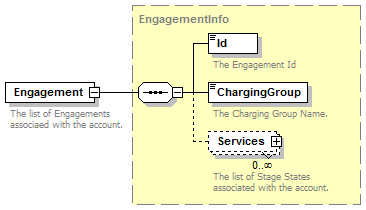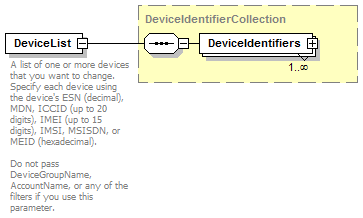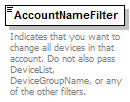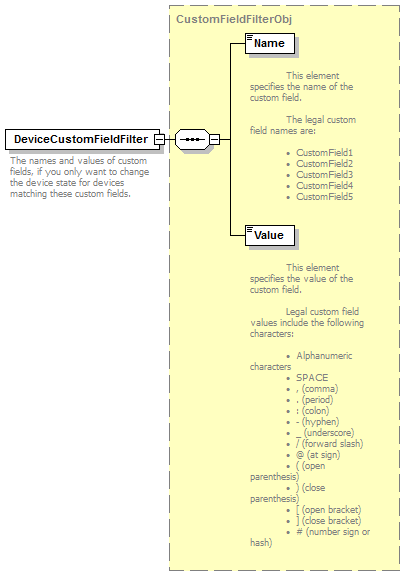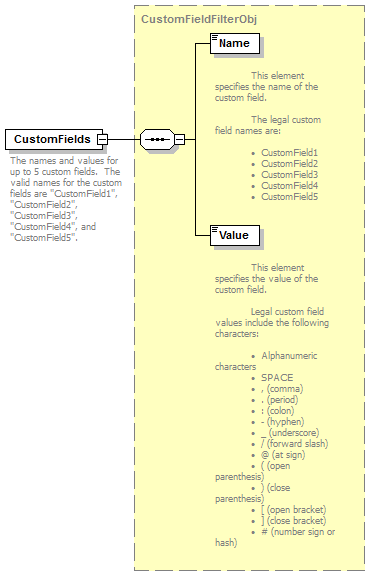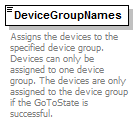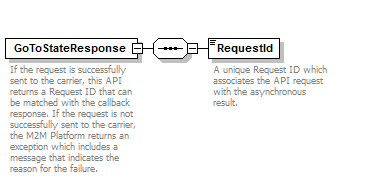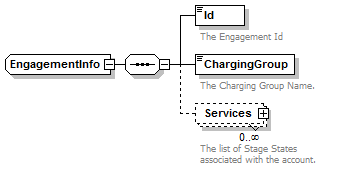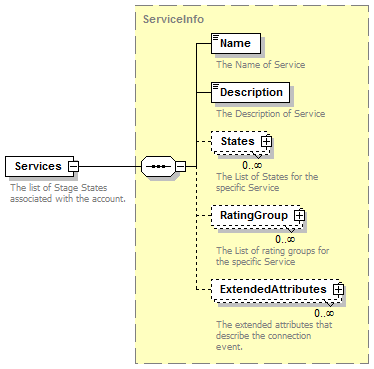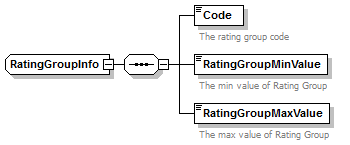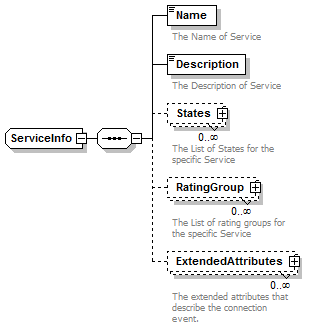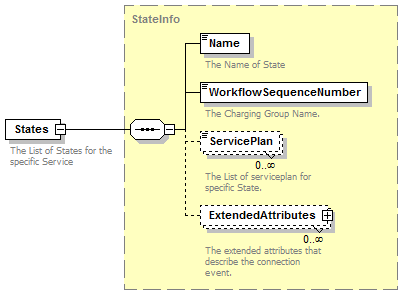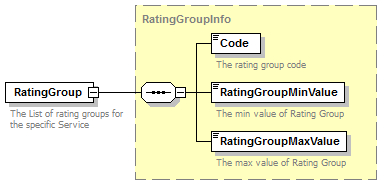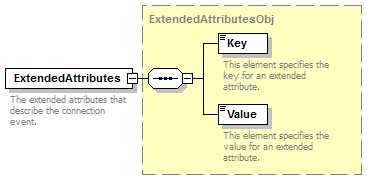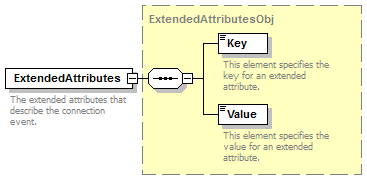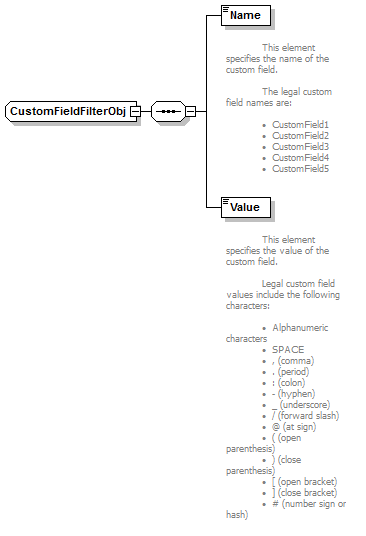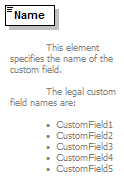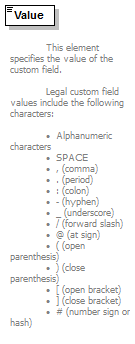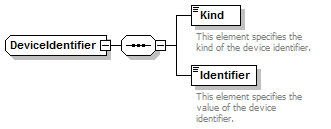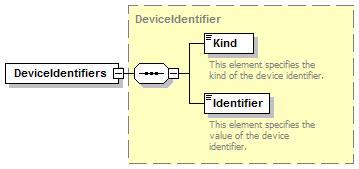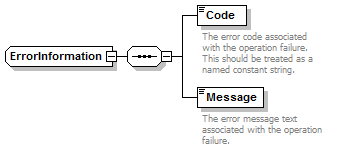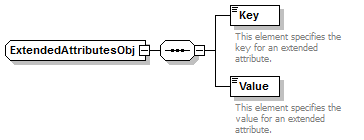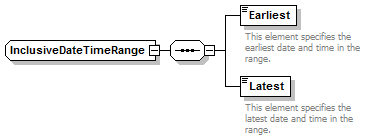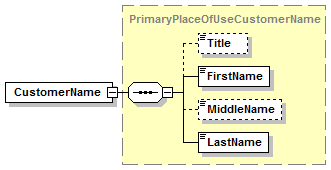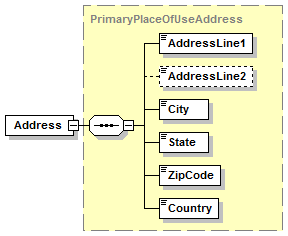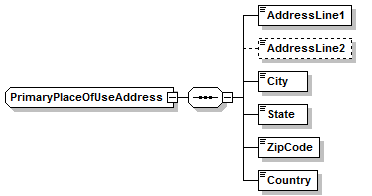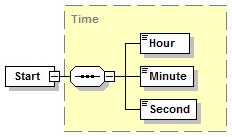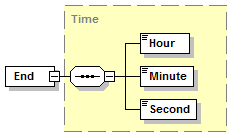| source |
<xs:element name="GoToStateRequest">
<xs:annotation>
<xs:documentation>Pushes a list of one or more devices to a specified state.</xs:documentation>
</xs:annotation>
<xs:complexType>
<xs:sequence>
<xs:element name="DeviceList" type="DeviceIdentifierCollection" nillable="true" minOccurs="0" maxOccurs="unbounded">
<xs:annotation>
<xs:documentation>A list of one or more devices that you want to change. Specify each device using the device's ESN (decimal), MDN, ICCID (up to 20 digits), IMEI (up to 15 digits), IMSI, MSISDN, or MEID (hexadecimal).
Do not pass DeviceGroupName, AccountName, or any of the filters if you use this parameter.</xs:documentation>
</xs:annotation>
</xs:element>
<xs:element name="AccountNameFilter" type="xs:string" nillable="true" minOccurs="0">
<xs:annotation>
<xs:documentation>Indicates that you want to change all devices in that account. Do not also pass DeviceList, DeviceGroupName, or any of the other filters.</xs:documentation>
</xs:annotation>
</xs:element>
<xs:element name="DeviceGroupNameFilter" type="xs:string" nillable="true" minOccurs="0">
<xs:annotation>
<xs:documentation>The name of a device group if you want to change all devices in that group.</xs:documentation>
</xs:annotation>
</xs:element>
<xs:element name="DeviceServicePlanFilter" type="xs:string" nillable="true" minOccurs="0">
<xs:annotation>
<xs:documentation>The name of a service plan to only change the device state for devices that have that service plan.</xs:documentation>
</xs:annotation>
</xs:element>
<xs:element name="DeviceCustomFieldFilter" type="CustomFieldFilterObj" nillable="true" minOccurs="0" maxOccurs="unbounded">
<xs:annotation>
<xs:documentation>The names and values of custom fields, if you only want to change the device state for devices matching these custom fields.</xs:documentation>
</xs:annotation>
</xs:element>
<xs:element name="ServiceName" type="xs:string" nillable="true" minOccurs="0">
<xs:annotation>
<xs:documentation>The service to push the device to.</xs:documentation>
</xs:annotation>
</xs:element>
<xs:element name="StateName" type="xs:string" nillable="true" minOccurs="0">
<xs:annotation>
<xs:documentation>The stage state to push the device to.</xs:documentation>
</xs:annotation>
</xs:element>
<xs:element name="ServicePlan" type="xs:string" nillable="true" minOccurs="0">
<xs:annotation>
<xs:documentation>Sets the service plan code that will be assigned to all specified devices. You must specify a service plan when you activate devices. You can use GetServicePlanList in the Account Service to find a list of valid service plan codes.
Verizon Wireless provides service plan codes at the time of on-boarding and subsequently whenever there are any changes to the service plan.
</xs:documentation>
</xs:annotation>
</xs:element>
<xs:element name="CarrierIpPoolName" type="xs:string" nillable="true" minOccurs="0">
<xs:annotation>
<xs:documentation>The pool from which your device IP addresses will be derived. If this element is not specified, the default pool will be used.</xs:documentation>
</xs:annotation>
</xs:element>
<xs:element name="MdnZipCode" type="xs:string" nillable="true" minOccurs="0">
<xs:annotation>
<xs:documentation>The ZIP code from which the MDN will be derived. Specify the zip code of the location where the line of service will primarily be used. If you do not specify a zip code, the ThingSpace Platform will assign the zip code associated with the service plan for the device.</xs:documentation>
</xs:annotation>
</xs:element>
<xs:element name="CustomFields" type="CustomFieldFilterObj" nillable="true" minOccurs="0" maxOccurs="5">
<xs:annotation>
<xs:documentation>The names and values for up to 5 custom fields. The valid names for the custom fields are "CustomField1", "CustomField2", "CustomField3", "CustomField4", and "CustomField5".</xs:documentation>
</xs:annotation>
</xs:element>
<xs:element name="DeviceGroupNames" type="xs:string" nillable="true" minOccurs="0" maxOccurs="unbounded">
<xs:annotation>
<xs:documentation>Assigns the devices to the specified device group. Devices can only be assigned to one device group. The devices are only assigned to the device group if the GoToState is successful.</xs:documentation>
</xs:annotation>
</xs:element>
<xs:element name="PublicIPRestriction" type="xs:string" nillable="true" minOccurs="0">
<xs:annotation>
<xs:documentation>Specifies whether the device has general access to the Internet. Valid values are “restricted” or “unrestricted”.</xs:documentation>
</xs:annotation>
</xs:element>
<xs:element name="SkuNumber" type="xs:string" nillable="true" minOccurs="0">
<xs:annotation>
<xs:documentation>Specify SKU (4G devices only). If you specify a SKU, supply only the SIM ICCID(s) in DeviceIdentifierCollection.</xs:documentation>
</xs:annotation>
</xs:element>
</xs:sequence>
</xs:complexType>
</xs:element> |



